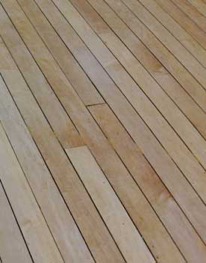 This time of year, the number one call we receive from our end user / customer, is “our floor is full of cracks, can you come and inspect it?”
This time of year, the number one call we receive from our end user / customer, is “our floor is full of cracks, can you come and inspect it?”
We are always very happy to inspect the gym floor and to see our customers again.
Nearly 100% of the time, we can diagnose the cracking or gapping issue as soon as the question gets asked. Maple is a hygroscopic material; meaning it will absorb and release moisture to meet its equilibrium with the atmosphere. That is a very technical sounding statement and can be scary. In reality, it’s very simple.
If the gym is dry, as is the case this time of year in our part of the World, the maple floor will begin to shrink as it loses moisture into the air. Conversely, in the summer, when humidity levels are elevated, the floor will grow as it absorbs moisture.
The Maple Flooring Manufacturers Association, the MFMA, recommends that the indoor relative humidity be maintained between 35 to 50% year-round. The MFMA has been the authority when it comes to maple floors since 1897 and this is the range they recommend. If the indoor atmospheric conditions can be maintained to be no wider than 20% year-round, then the issue of gapping would be lessened.
In the upper Midwest, controlling indoor relative humidity in a large room, such as a gym, is a very difficult task. This year, the dryness seems to be more of an issue than others in recent memory. In fact, we just completed a floor where the owner and GC had to add a temporary humidification system just to get to the recommended level. It’s only the second time in nearly 40 years of business that I recall that happening.
Many times, an affordable way to introduce humidity into a gym is to open the dampers in the HVAC system if, and only if, the outside air is holding more moisture than the indoor relative humidity. This technique must be done with constant attention to the conditions both outside and inside. It is heavily recommended that a qualified HVAC contractor be monitor the conditions 24 hours a day with an eye the forecast of the weather.
Here, North of Chicago, we have had a VERY dry winter. No snow in January or February and only 17.7” of snow for the entire season.
The bottom line is this: almost every time we get a call about cracking floors this time of year it’s due to the indoor relative humidity being too low. The floor will “repair” itself as we enter springtime and more humid air is introduced into the gym.
The key, is to limit the indoor relative humidity swings to 35-50%. If you are concerned about the gapping, please contact Floors Incorporated, and we would be happy to meet and discuss your maple or synthetic gym floor.
